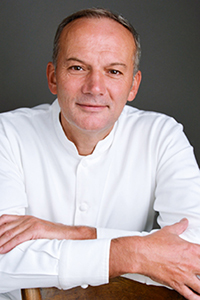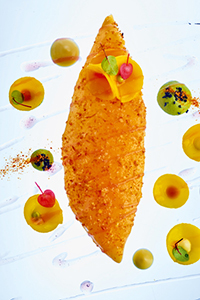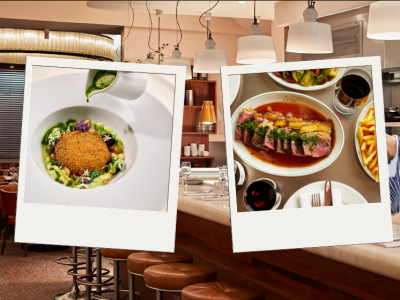Line-fished sea bass, caviar, fermented milk from my childhood,” reads the menu. It’s the reason I’m here. It is three Michelin-starred Paris chef Christian Le Squer’s most famous dish and it won’t be coming off the menu anytime soon. He devised it at Pavillon Ledoyen in Paris and the dish has come with him to Le Cinq, his new home at the Four Seasons Hotel George V. It doesn’t disappoint. Simple, elegant, delicate — a personal tribute to the sea and a poignant reminder of Brittany-born Le Squer’s coastal heritage.
Creating a signature dish with Christian Le Squer
14th March 2015
Why does one culinary creation endure, while another disappears off the menu without a trace? Fiona Sims discusses the birth of a signature dish with French chef Christian Le Squer
I love it — and so do the hundreds Le Squer has fed since he launched the dish three years ago. But just how does one dish endure and another fade? “It’s the guest who decides that, not me. They tell their friends, who pass it on and so it happens,” says Le Squer with a shrug.

Cue the signature dish. It’s the talk of the town — before diners have even tasted it — and can even start trends with copies, or versions of it, popping up in restaurants across the globe. Although it has to move with the seasons with an ingredient tweak here or a substitution there, it also has to be consistent and stand the test of time. Can you ever take it off the menu? Not unless you want a riot.
Some chefs (and critics) will grumble that the signature dish is rather like a hit song that’s overplayed, preferring their customers to take a more flexible approach to dining. Not Le Squer. “I actually like the term. I think it’s important to have signature dishes on a menu — diners look forward to eating it. But don’t have more than three on the menu, ideally one for each section,” he advises.
“For me a signature dish has be full of flavour, but it has to evolve, too, it can’t be the same all the time,” he stresses. “My sea bass, for example, is garnished with a couple of crisply cooked, new season’s asparagus from the Vaucluse, although come the autumn it might be sliced ceps.Thefermented milk, though, is a constant.” Lait ribot, the traditional Breton name for the fermented milk, brings back memories for Le Squer: “In the old days, people ate it with cooked potatoes. I had it all the time as a small boy. I love that milk and I wanted to do a fish dish with it.”
Le Squer grew up in the tiny Breton seaside village of Plouhinec. He wanted to be a chef at 14 years old after spending two weeks cooking for the crew on a fishing boat. “That was it — I knew what I wanted to do,” he remembers. “I’ve always had the smell of the ocean around me, so yes I love cooking fish. I don’t cheat when it comes to my fish dishes either — by that I mean that I love fish served simply, with nothing that gets in the way of the flavour. With the sea bass I use caviar to salt the dish without actually adding any salt. Then all I add is the ribot and a little cream. That’s it.”
So what of Le Squer’s future signature dishes? After 12 years at Pavillon Ledoyen, where he won his third Michelin star at the age of 38 and only five years after winning his first star, he stunned the French capital by upping sticks for Le Cinq where he is making plans.
“The resources are huge here — I get a team of research and development chefs, which I’ve never had before,” he says. He leads me to his daily review during which, every day at noon, his chefs nervously show him the combinations they have been working on for a final tweak on a new dish that is fast becoming the latest signature: “Black rice lightly smoked, creamy black pudding, passion fruit juice, coffee”.
“I’m very excited about this dish. It’s a surprise to see boudin noir in a restaurant like this. It’s a very rustic ingredient, and this is a palace. But I want to change the way people eat in places likes this,” he says.
The boudin noir sausage, served as super smooth purée shaped into a gateau-like slice, topped with crunchy black Venetian rice, is surprisingly light, the sharp kick of acidity from the passion fruit cutting through the richness.
“Women particularly love this dish. And it is mainly women that I cook for,” he says. “After all, it is mostly women who choose which restaurant to eat in. I think women are more adventurous, more open to new flavours and new dishes, more curious in general, in fact. Men tend to go with what they already know. And as long as I have women in my restaurant, I will have men, too,” he reasons.
The dish is all black, too, with tiny accents of orange — how Parisian. Indeed fashion, it turns out, plays a big part in Le Squer’s creative process. He draws ideas from magazines and boutiques, even the catwalk, favouring individual designers rather than brands. “French women love their Chanel suits. But the design is tweaked constantly: it’s the same, but it has changed a little bit, you understand? “ He grins: “Not unlike the signature dish.”
The Gourmand Lunch Menu at Le Cinq starts from €145 for four courses, while the The Epicurean Escape dinner menu starts from €310 for nine courses (both prices exclude any beverages). www.fourseasons.com/paris
Three Michelin star-defining signature dishes
“Five ages of Parmigiano Reggiano”
- Cheeses aged from 25 to 50 months are offered in five different textures, from soufflé to foam, galette to sauce.
- The Chef: Massimo Bottura
- The Restaurant: Osteria Francescana, Modena, Italy, +39 059 223 912, www.osteriafrancescana.it
“From egg to chicken”
- Low temperature cooked eggs, with a crackly “paper” made from yolk are surrounded by crisp crumbs of chicken skin with a whiff of truffle. A rich, clear bouillon is poured over the top.
- The Chefs: Juan and Elena Arzak
- The Restaurant: Arzak, San Sebastian, Spain, +34 943 278 465, www.arzak.info
“Sound of the sea”
- Does sound influence the perception of flavour? You decide. A conch shell containing a small MP3 player with a recording of waves crashing on the shore accompanies the dish of tapioca “sand”, mushroom, mackerel, halibut, kingfish, pickled seaweeds and “sea” foam.
- The Chef: Heston Blumenthal
- The Restaurant: The Fat Duck, Bray, Berkshire, UK, +44 (0)1628 580 333, www.thefatduck.co.uk (re-opens in the latter half of 2015 after refurbishment)
Credits: Sergio Coimbra; Gilles Dacquin; Paolo Terzi; Bernhard Winkelmann; www.coconut-ss.com







